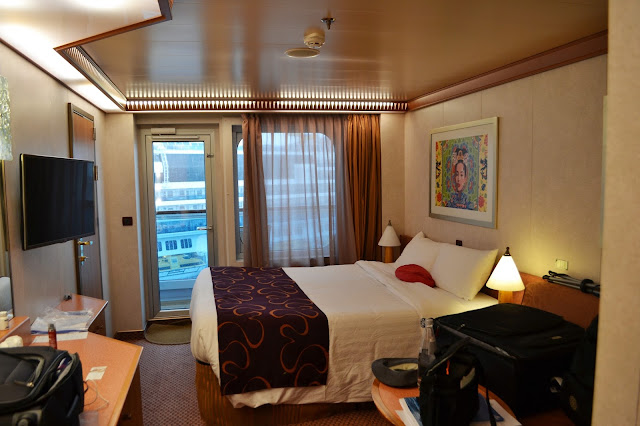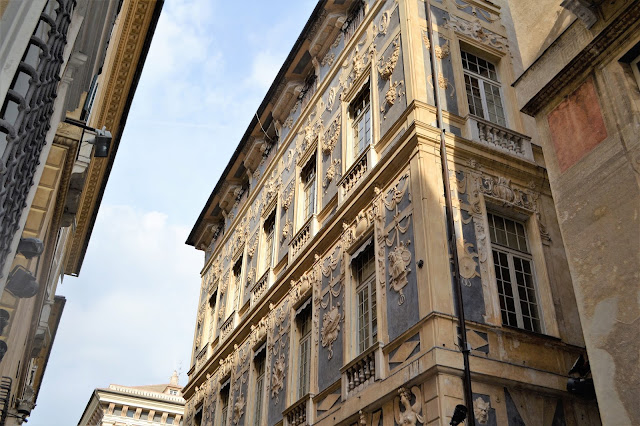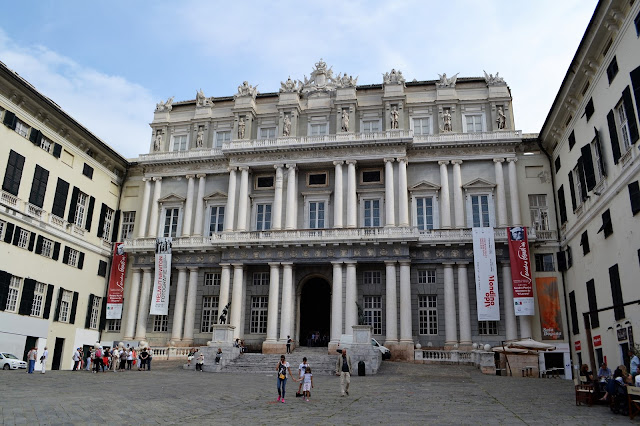We booked a balcony room for this cruise. It was amazing to be able to sit outside in the morning and watch the sunrise.
When we do another cruise it's going to be painful to go back to the windowless, tiny cabin that normally fits our budget.
It's a good thing there were so many wonderful places to visit on land or we may have become cabin potatoes.
Today we are in Genoa and Savona, two important ports of Italy.
See the Ikea sign atop the tall white pole in the center of the picture? Yep, Ikea has come to Italy.
So has graffiti. Apparently Italy is well known for its graffiti. I'm not sure a) what they're rebelling about and b) when they will know it's the end or c) what "calp" means.
We walked passed this ship from a movie set from the Roman Polanski movie Pirates.
"We must not ask for permission to be free."
Even churches invite graffiti postings.
"Break down borders" and "Solidarity with the Brenner" (an area of Italy).
Later, in Savona, we saw truly interesting graffiti/art like this.
Genoa has been inhabited since the fifth or fourth millennium BC.
Genoans invented "blue jean", used to cover and protect things on docks. Later this fabric was exported throughout Europe. As we know blue jeans have now pretty much taken over the world.
Genoa was also home to the boy Christopher Columbus, as well as a Renaissance magnet for such famous artists as Caravaggio, Rubens, and Van Dyck, as well as many other famous artists and architects. Genoa was an important Renaissance center.
Genoa is famous for their key participation in developing the modern banking system, opening two "first" banks in the 1400's: Bank of St. George and Banca Carige. Mostly, it's an important city because of its location on the sea.
Genoa has also had its share of hardships, including the Black Death in 1347, likely brought from China by Genoese traders, killing and estimated 30%-60% of European population. The Black Death was followed by the Plague in 1656-57. The Plague wiped out half of the population.
Genoa also had their share of wars. They endured many attacks over the years and were an easy naval and aerial target during WW II, when the city was heavily damaged.
I really love the serene colors of their cityscape. Genoa has a population of nearly 600,000, and feel they have reached their capacity for growth. The city has such character. I hope they never feel it with high rises and new buildings.
This tunnel is famous for being the place American soldiers came through after the city was liberated at the end of WW II by the Italian Resistance Movement.
The tunnel, built in 1927, is named after Giuseppe Garibaldi, famous politician, military man, and Italian uniter of the mid 1800's.
We saw a rare car or motorcycle on these streets, but most of the traffic was pedestrian.
The Italy flag designates this as a government building.
Trompe l'oeil is a popular style. Some of it is quite convincing.
We walked down Via Garibaldi, the old center of Genoa where the rich and the royalty built palaces. This is Palazzo Podesta (or Palazzo Lomellini),
built between 1559-1565 by a rising political and economic star.
Currently you can rent space for a business meeting. I can't imagine getting much business done with so much beauty to look at.
Our next stop was Palazzo Rosso, a palace built between 1671-1677.
I managed to get a picture of some visiting dignitaries.
This was a palace we actually went inside of to look around.
These Italians love their marble and open courts.
These Italians love their marble and open courts.
Palazzo Rosso was originally built for the Brignole family, who governed Genoa for several years.
The palace is now owned by the city of Genoa, as are the other palaces, and has become an important picture gallery.
These three dimensional-looking walls are all trompe l'oeil, and despite appearances,
were all quite flat.
The ceilings were painted by some of the best known local artists.
I gave myself a stiff neck looking at them for the next 45 minutes.
There were also paintings by famous artists, like Christ Carrying the Cross by Van Dyke. Sorry for the blurry picture, taken at an awkward angle, without a flash.
A few more paintings caught my eye, like this mother and daughter in uncomfortable looking dresses. I don't know the artist.
The raised surfaces in all of these rooms are tromple l'oeil, skillfully done.
The dimensional appearance of the ceiling is also trompe l'oeil.
Praying Madonna by Guido Reni
More ceiling detail: an Alice in Wonderland-type face,
Some more magnificent trompe l'oeil. "Trompe l'oeil" translates as "optical illusion". I had to study this one to see if I was really seeing a crumbling ceiling, or just a clever painting.
Palazzo Rosso had a variety of works of art.
I couldn't decide if this was a real drying rack for fish or a work of art.
Since this was actually a home, we passed through the bedroom. That bed doesn't look very comfortable. I'm hoping it's a display bed, made of cardboard, like you see in home shows. I'd like to believe the real bed was nicer.
This is a portrait of a Brignole Sale mistress of the manor, owner of the bedroom. It was painted by Hyacinthe Rigaud, known for his ability to capture "exact likenesses" including fashion and background details. This portrait was probably painted around 1670.
One of many beautiful marble floors.
One of many beautiful gelato places.
Piazzo De Ferrari is the center of Genoa.
The center building is the stock market building- Palazzo della Nuova Borsa
.
The center building is the stock market building- Palazzo della Nuova Borsa
.
This military statue of Italian King Vittoria Emanuele II is in the same place Italy burned witches at the stake. Vittoria lived a couple of hundred years later.
Detail of the fancy stock market building, built in 1912.
The city square is also home to offices, banks, insurance, and other private businesses.
We made a quick stop at Christopher Columbus's boyhood home. Sadly, it's not the grand castle-y thing up the road, it's the vine covered house on the right.
Columbus's house is pretty small and simple,
and currently a museum that we didn't have time to go in.
and currently a museum that we didn't have time to go in.
That's quite the vine.
The nearby towers were originally watchtowers, built in 1155. They were later used as prisons. Prisoners in a tower are so cliche.
Behind the Columbus house are the remains of a lovely garden. I think the garden was probably more impressive than the house.
The towers were originally part of the longest wall in Europe, built for protection.
I like this painting on a church along our way.
The impressive city gate of Genoa.
Is it just me, or does he look familiar?
Our next stop was Palazzo Ducale, the palace of the Doges, or chief magistrate of Genoa.
Renovations took place in 1590 and 1777. A major restoration took place in 1992, in connection with the 500th anniversary of Columbus's discovery of America.
The home is now used for a museum and a place to hold cultural events.
This house has more than 48,000 square feet, making it a few steps above a starter home.
Genoa `has tons of interesting buildings.
I think it would take a year to see everything.
These Genoese like their catwalks.
Dark green shutters indicate we are in the old section of town.
Our final stop is the Genoa Cathedral, aka St. Lawrence Cathedral.
The original cathedral on this spot was founded in the 5th or 6th century AD
The current cathedral was built in 1155, damaged by fire in 1296, rebuilt between 1307-1312.
Various altars, chapels, and other parts were added over the centuries and by the 17th century it was finished in its current form. The style is Romanesque.
St. Lawrence was a deacon, martyred by the Emperor in 258 AD.
Our limited time did not allow us to explore every corner of this cathedral.
I later read that John the Baptist's ashes are here, although it turns out they own the ceremonial casket, dating back to the 1400's used to put the ashes in during processions.
Like many ancient churches, this spot was originally a cemetery. Here, so long ago pope uncomfortably rests for eternity on his stone pillow.
The cathedral has a museum beneath the building which houses the John the Baptist casket, as well as a silver bowl supposedly the chalice used by Christ at the Last Supper. Sadly, we weren't able to go downstairs because of the number of people and our limited time.
It's been a fun day, ended all to soon by the need for us to
catch our ride.





















































































I love the graffiti shots at the beginning of this post. I really enjoy the various styles of graffit around the world. And only one gelato picture? Were you ill? I do love the zebra-stripe buildings of this region of Italy. We haven't been to Genoa. I can tell we need to add it to our list!
ReplyDeleteI've always had an interest in Genoa, fun to see it through your eyes. I've never seen a picture of Columbus' home, very cool. And love the cathedral. I think of the University of Genoa, Genoa salami, Columbus and the arts.
ReplyDelete